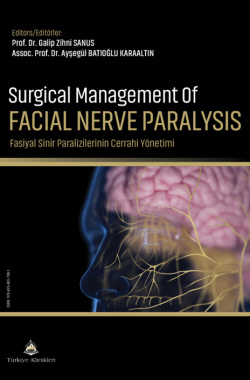Eyelid Reanimation in Facial Paralysis
Yavuz TULUYa, Levent YOLERİb
aTurgutlu State Hospital, Clinic of Plastic, Reconstructive and Aesthetic Surgery, Manisa, Türkiye
bManisa Celal Bayar University Faculty of Medicine, Department of Plastic, Reconstructive and Aesthetic Surgery, Manisa, Türkiye
Tuluy Y, Yoleri L. Eyelid reanimation in facial paralysis. In: Sanus GZ, Batıoğlu Karaaltın A, eds. Surgical Management of Facial Nerve Paralysis. 1st ed. Ankara: Türkiye Klinikleri; 2022. p.200-4.
ABSTRACT
Inability of eyelids movements, epiphora and lower lid sagging are the major problems in paralytic eyelids. There are many techniques described in the literature including static and dynamic procedures. Gold weight is one of the most popular static procedure. Eyelid closure can be gained by applying muscle transfers. Modified temporalis muscle transfer can be used for this purpose. A muscle mass from the anterior third of the muscle with overlying fascia is dissected. Twice as much muscle to the upper eyelid than the lower eyelid is taken and passed muscularly 5 to 6 mm away from the limbus for upper eyelid and a thinner muscle mass is passed subcutaneously beneath the lower cilia for lower eyelid. These strips is stitched to the medial canthus and 3-to 4 mm above it. Although there is no consensus on which technique is better, modified temporalis muscle is easy to apply compared with the microsurgical techniques.
Keywords: Facial paralysis; eyelid reanimation; temporalis muscle
Kaynak Göster
Referanslar
- Bentivoglio AR, Bressman SB, Cassetta E, Carretta D, Tonali P, Albanese A. Analysis of blink rate patterns in normal subjects. Mov Disord. 1997;12(6):1028-34. [Crossref] [PubMed]
- Yoleri L, Songür E. Modified temporalis muscle transfer for paralytic eyelids. Ann Plast Surg. 1999;43(6):598-605. [Crossref] [PubMed]
- Terzis JK, Bruno W. Outcomes with eye reanimation microsurgery. Facial Plast Surg. 2002;18(2):101-12. [Crossref] [PubMed]
- Jobe RP. A technique for lid loading in the management of the lagophthalmos of facial palsy. Plast Reconstr Surg. 1974;53(1):29-32. [Crossref] [PubMed]
- Terzis JK, Konofaos P. Nerve transfers in facial palsy. Facial Plast Surg. 2008;24(2):177-93. [Crossref] [PubMed]
- Gillies H. Experiences with fascia lata grafts in the operative treatment of facial paralysis: (Section of otology and section of laryngology). Proc R Soc Med. 1934;27(10):1372-82. [Crossref]
- Evrenos MK, Bali ZU, Yaman M, Yoleri L. Modified temporalis muscle flap for eyelid reanimation. J Craniofac Surg. 2018;29(7):e649-e54. [Crossref] [PubMed]
- Elazab EE, Abdel-Hameed FA. The arterial supply of the temporalis muscle. Surg Radiol Anat. 2006;28(3):241-7. [Crossref] [PubMed]
- Terzis JK, Olivares FS. Uses of the superficial temporal fascial flap in facial paralysis. Plast Reconstr Surg. 2008122(6):176e-85e. [Crossref] [PubMed]
- May M. Muscle transposition for facial reanimation: indications and results. Otolaryngol Head Neck Surg. 1984;92(1):85-7. [Crossref] [PubMed]
- May M, Drucker C. Temporalis muscle for facial reanimation. A 13- year experience with 224 procedures. Arch Otolaryngol Head Neck Surg. 1993;119(4):378-82; discussion 383-4. [Crossref] [PubMed]
- Deutinger M, Freilinger G. Transfer of the temporal muscle for lagophthalmos according to gillies. Scand J Plast Reconstr Surg Hand Surg. 1991;25(3):277-80. [Crossref] [PubMed]

